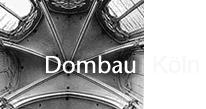
The revealed underdrawings of the ‘Altarpiece of the City Patron Saints’ were mostly made using brushes (inside of left-hand wing, and central panel) or quills (outsides of wings, and inside of right-hand wing) and a black liquid drawing medium. Only on the central panel could we discern thick brush lines suggesting the more likely use of paint rather than drawing inks or the like.
In their manner and style, the different compositions differ from each other to the extent that we believe that at least four skilled draughtsmen were involved. One of these was clearly Stefan Lochner, although his characteristic style is only discernible in the underdrawings of the inside of the left-hand wing and in places on the central panel.
As the underdrawings do not in general reveal any development in the form and arrangement of the figures, or of the perspective construction, we must presume there to have been preliminary drawings separate from the panels. There is much evidence to indicate that these preliminary drawings did not take the form of detailed compositional lay-ins. They may even only have been small-format drafts, such as were usual in order to present the composition to the client, or as the basis for a contract. That these separate preliminary drawings did not illustrate all the motifs in detail, and that in all probability further patterns were used, is strongly suggested by the underdrawings of the fictitious banner of St Ursula on the inside of the left-hand wing, and the banner with a depiction of a moor on the central panel. It is quite possible that the motifs and compositions of the separate patterns and preliminary drawings were transferred largely freehand to the panels. However the existence of guide lines or further preliminary graphic stages cannot be ruled out, as not all such lines can be revealed by infrared radiation.
While the underdrawings themselves are fascinating, the numerous disparities between them and the pictures as subsequently painted are notable and informative at the same time. These disparities, while rarely affecting the basic compositions, do involve many details. Some of the changes may have come about as a result of revisions of the underdrawings in the workshop. Other, in some cases major changes in the painting vis-à-vis the underdrawing point to external intervention, possibly by the client. Thus could explain for example, on the insides of the two wings, the far milder contrast in the painting than in the underdrawing between the charm of Ursula’s companions and the bellicose aspect of the Theban Legion under their officer Gereon. The curtain in the background of the outsides of the wings, whose patterns and folds were presumably completely underdrawn, together with the direction lines of the dove as it flies in, could even point to a previously agreed preview by the client. From the purely technical point of view, such lines would not have been necessary for a curtain that was going to be decorated with pressbrokat in any case. There is also more than a possibility that the presumed inspection of the underdrawings took place even after the painting process had begun. For example the originally planned form of the Virgin’s cloak on the outside of the left-hand wing was already laid-in in paint before a major change was made in the underdrawing, and it was this changed version that was eventually painted. The in places very rapid and extremely sketchy underdrawing of the heads in the background of the inside of the right-hand wing could point to a certain speed, not to say haste, in the execution of the commission for the altarpiece.
All in all, we have gained numerous important new insights not only into the genesis of this outstanding work of Cologne panel-painting in the late Middle Ages, but also into the staffing, organization and practice of the workshop of its most famous representative, Stefan Lochner.

